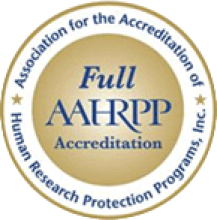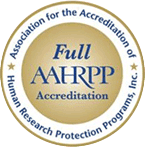Index
IRB Efficiency Initiative: Recordings, Supplemental Documents and FAQs
AAHRPP Accreditation Review – Organization, Part One
Annual Disclosure of Outside Activities Due April 30
New! Template Recruitment Message
Herky Hint: UIHC Clinical Trials website: After close of enrollment
Draft Guidance on Key Information in Informed Consent
In the News
IRB Efficiency Initiative: Recordings, Supplemental Documents and FAQs
By Kelly O’Berry, BS, CIP
A recording of the February 28 IRB Efficiency Initiative Information Session is now available on the web site. There are new supplemental documents about the January 29 changes posted in the IRB ICON Course for Researchers, under IRB Efficiency Initiative-Recordings and Documents. This article also contains answers to common questions we received about the revisions to Section III (Funding/Other Support)
February Information Session
If you missed the January or February information sessions, or if you just want a refresher, you can view recordings on the Information Session tab of the IRB Efficiency Initiative website. In addition, there are brief (less than 10 minute) recordings about the three changes that rolled out on January 29, 2024.
There were no new changes rolled out in February, but during this info session we:
- Reviewed January 29 changes and shared preliminary evaluation data.
- Provided an overview of changes that will roll out on April 1.
- Announced the new recruitment message template.
- Announced updates to the Short Form Consent Document and Process educational tool.
- Gave a reminder about the IRB Efficiency Initiative communication plan and resources.
Supplemental Documents
In addition to brief recorded tutorials for each of the January 29 changes, there are now supplemental documents for each of these changes posted in the IRB ICON Course for Researchers. These documents contain the same information as the recordings, plus screenshots from the HawkIRB system. We hope these documents are useful for learning about the changes:
- 60-day withdrawal of forms due to PI inactivity
- Sending Required actions BEFORE the IRB meeting minutes
A supplemental document already had the Help Message content for the revisions to Section III about funding and other sources of support.
In the IRB ICON Course, you can also access the January and February Information Session recordings and the slides from each session.
Frequently Asked Questions About the Revised Section III (Funding/Sources of Support)
The following are common questions we received after rolling out the Section III redesign:
Question: Should I wait to submit the New Project Form (or add new funding to an approved study) until the grant or contract has been routed through the eDSP system?
Answer: Yes! If you select external funding via grant or contract, you must link to the funding source in Section III.2. The UIRIS routing form must have all necessary approvals and complete the Division of Sponsored Programs (DSP) intake process before you can link to the funding source in HawkIRB.
Question: How does the DSP review process for routing forms affect researchers who are completing a HawkIRB New Project form or a Modification form to add a funding source?
Answer: DSP has a prescreen process for routing forms, similar to the prescreen process HSO staff use with HawkIRB forms. Once the routing form completes the prescreening (or intake) process, the PI and/or HawkIRB Delegate can link to that funding source in Section III.2. That is why it is important to submit the routing form in eDSP before you submit the HawkIRB form.
Question: What conditions should be considered with the change in how DSP approval is issued in HawkIRB?
Answer: DSP approval is now granted in HawkIRB when the contract terms have been agreed upon. This is a change from how this was handled in the past. Even though, the research project has been released to the study team, it does not mean the research can begin. The PI/Dept are responsible for exercising caution to ensure cost recovery if the following conditions are not met before beginning the research:
- The contract and budget are fully executed.
- The Master File Key (MFK)/Award Authorization Activation Notice (AAAN) is issued to the study team.
If there are questions regarding the status of either of these items, the study team should reach out to their departmental administrator or DSP at dsp-contracts@uiowa.edu.
Question: Why can’t faculty and staff Principal Investigators select “No Funding” in Section III.1?
Answer: In consultation with the Division of Sponsored Programs, the Human Subjects Office revised Section III.1 to capture financial and other sources of support. UI faculty and staff receive salary support, office space, office furniture, technology equipment, IT support, administrative services and other institutional support (electricity, heat, water, etc.). If no other source of funding/support applies, faculty and staff researchers should select “Departmental” support in Section III.1.
Question: What funding source options do VA researchers have in Section III?
Answer: For research submitted to IRB-03, Section III.1 only contains four options for funding/source of support:
- The funding award (contract/grant) has been routed through Iowa City VAMC Research Office. [NOTE: This refers to the VA Health Care System Research Office.]
- In-Kind Donations
- PI Discretionary
- Departmental
Please use the Help messages in Section III for additional guidance on how to accurately respond to these questions.
AAHRPP Accreditation Review – Organization, Part One
This is the third article in a series about AAHRPP accreditation.
The focus of Domain I is on how the institution is structured to support and meet the obligations of the Human Research Protection Program (HRPP). [Read more]This article will provide an overview of the first Standard under this Domain and how the UI satisfies them.
DOMAIN I: Organization
Under the Organization Domain, there are nine separate Standards that address the various Elements that “demonstrate that the human research protection program is systematic and comprehensive, and that it provides protections for all research participants.” Validation of the Standards includes an assessment of the knowledge about the HRPP policies and procedures within the institution.
The first Standard, (Standard I-1) states:
The organization has a systematic and comprehensive Human Research Protection Program that affords protections for all research participants. Individuals within the organization are knowledgeable about and follow the policies and procedures of the Human Research Protection Program.
Each Standard contains specific Elements that must also be addressed. For example, Standard I-1 contains eight separate Elements.
ELEMENT I.1.A.: The organization has and follows written policies and procedures for determining when activities are overseen by the Human Research Protection Program.
ELEMENT I.1.B.: The organization delegates responsibility for the Human Research Protection Program to an official with sufficient standing, authority, and independence to ensure implementation and maintenance of the program.
ELEMENT I.1.C.: The organization has and follows written policies and procedures that allow the Institutional Review Board or Ethics Committee to function independently of other organizational entities in protecting research participants.
ELEMENT I.1.D.: The organization has and follows written policies and procedures setting forth the ethical standards and practices of the Human Research Protection Program. Relevant policies and procedures are made available to sponsors, researchers, research Staff, research participants, and the Institutional Review Board or Ethics Committee, as appropriate.
ELEMENT I.1.E.: The organization has an education program that contributes to the improvement of the qualifications and expertise of individuals responsible for protecting the rights and welfare of research participants.
ELEMENT I.1.F.: The organization has and follows written policies and procedures for reviewing the scientific or scholarly validity of a proposed research study. Such procedures are coordinated with the ethics review process.
ELEMENT I.1.G.: The organization has and follows written policies and procedures that identify applicable laws in the localities where it conducts human research, takes them into account in the review and conduct of research, and resolves differences between federal or national law and local laws.
ELEMENT I.1.H.: The organization has and follows written policies and procedures specifically designed to protect the rights and welfare of research participants during an emergency.
AAHRPP provides an Evaluation Instrument for Accreditation that outlines what information is to be provided with the application for each Standard and Element. For example, Element I.1.A focuses on the policies and procedures defining activities overseen by the HRPP and requires that written materials define “research involving human participants” so that all persons involved in the HRPP understand which activities are in its purview. It also requires that written materials describe the process to provide determinations about whether an activity is research involving human participants. The application and supporting documents must provide:
- A description of the scope of human subjects research that requires review by the organization’s IRB
- A description of the criteria by which persons are considered engaged in the research and come under the requirements of the IRB
- Guidance concerning activities that sometimes are or are not overseen by the HRPP, such as classroom research, quality improvement, case reports, program evaluation, and surveillance activities
- A definition of any other activities the organization considers research, when these are outside the scope of activities covered by regulations or laws
- When activities are covered under other laws, (such as HIPAA) the definition encompasses activities that are “research involving human participants” as defined by those laws
- A description of the process the organization uses to track all open studies
- The process for registering IRBs when required by regulatory agencies
- The process for following the regulations of research under the following agencies:
-
- Department of Health and Human Services (HHS)
- Department of Defense (DoD)
- Department of Education (DOE)
- Department of Justice (DOJ)
- FDA
- Department of Veteran Affairs (VA)
-
In the process of submitting the application for re-accreditation to the AAHRPP, the UI HRPP will provide more than 1,000 (electronic) pages of documentation. These documents will support the institutional alignment with the required elements and standards of human research ethics that are the focus of the accreditation process.
Most of the supporting documents provided by the UI HRPP come from information, guidance, articles, and policies that are available to the UI research community in the following locations:
As an example, the supporting documents submitted previously under Standard I for Element I.1.A come from three main sources:
‘UI IRB Standard Operating Procedures and Researcher Guide’:
- Introduction to the University of Iowa Human Research Protections Program
- Components of the HRPP
- University of Iowa Institutional Review Board (IRB)
- Regulatory Requirements for IRB Review
- University of Iowa projects involving human subjects or their data
- Exempt Human Subjects Research
- Expedited Review
- Full Board Review
- HawkIRB Section VI Subject Enrollment
- Frequently Asked Questions: IRB Approval
- Human Subjects Research Determinations Booklet
- Research at the VA Health Care System (VAHCS)
- FDA Site Inspection Guide
- Researcher Handbook
Handouts, Templates and FAQs
- Do I Need IRB Review?
- HSO Controlled Substances Standard Operating Procedures
- Investigational New Drug (IND) Educational Visit Standard Operating Procedures (SOP)
- University of Iowa Organizational Chart
- DoD Researchers Guide Section 2
- DoD Assurance
- DoD-DOA Assurance Document
- DoD-Department of Navy (DON) Assurance Document
- External IRB SOP Section VI.A-C
And that’s just for one of the Elements! The supporting documents under each of the other Elements and Standard will be more or less detailed, depending upon the focus of the inquiry.
In our next installment about AAHRP Accreditation, we will provide additional insights into the remaining AAHRPP Standards and Elements under the Organization domain.
The information for this article was adapted from the AAHRPP website.
Annual Disclosure of Outside Activities Due April 30
By Martha Hedberg, MPA
All UI faculty and staff identified as key personnel that conduct human subjects research are required to complete an “Annual Disclosure of Outside Professional Activities and Interests” via the eCOI online disclosure portal by April 30, 2024. This article describes the disclosure requirements and highlights new questions that were added to the eCOI disclosure form in 2024.The University of Iowa community is committed to the principle of free, open, and objective inquiry in the conduct of its teaching, research, and service missions. Further, the University of Iowa encourages its employees to engage in external activities that promote the University's mission, contribute to their professional fields, enhance their professional skills, and/or enhance the public good. To ensure that external activities are conducted in a manner consistent with institutional and public values, policies have been established to ensure that University employees avoid improper conflicts, and otherwise disclose activities for review and management.
Employees may monitor compliance with this annual disclosure requirement via the UI Compliance and Qualifications system accessible through UI Self-Service “My Compliances” tab. Employees who have not completed the requirement will receive reminder emails on April 1, April 25, and April 30. Supervisors and Compliance Administrators will be copied on the final two notifications. After April 30, employees may add new, review or edit previously-submitted reports directly using https://ecoi.uiowa.edu.
Implications of the Annual Disclosure Requirements with Human Subjects Research
If research team members identified as key personnel have not completed the 2024 annual disclosure by May 1, 2024, HawkIRB will flag them as noncompliant. This flag will prevent the Principal Investigator (PI) from submitting any new projects, modifications or continuing reviews to the IRB until the annual disclosure of the research team member is complete. An incomplete annual disclosure could result in removal of the team member from the IRB application and thus, participation in the conduct of any research related activities.
Who Should Disclose
Under this policy, “key personnel” means anyone involved in the design, the conduct and/or the reporting of the research. These roles are specified because they provide opportunities for the introduction of bias into the research. If you are unsure if this applies to you, check with the PI of any studies in which you are a research team member. HawkIRB automatically defines the PI and any research team members with a faculty appointment as key personnel.
What to Disclose
Disclosures should be submitted to the University for any outside activities and interests that are related to an employee’s role or area of expertise at the University. For more detail about what types of activities to disclose, see the Conflict of Interest in Research’s website.
International Engagement
The eCOI system continues to collect information about international engagement. NIH Grants Policy Statement defines a Foreign Component or engagement as “any significant scientific element or segment of a project outside of the United States, either by the recipient or by a researcher employed by a foreign organization, whether or not grant funds are expended" and includes “collaborations with investigators at a foreign site anticipated to result in co-authorship; use of facilities or instrumentation at a foreign site; or receipt of financial support or resources from a foreign entity.”
International collaboration is often an important aspect of those activities. To ensure it is conducted in a manner consistent with institutional and public values, policies have been established to ensure that UI employees avoid improper conflicts by disclosing those relationships for review and management. Full and timely disclosure regarding research support and conflicts of interest is essential to ensure compliance with federal regulations and sponsor requirements.
Failure to disclose this information can have significant fiscal and regulatory consequences, impacting both the individual PI and the institution. This addition will assist with identifying possible risk to research integrity and security which may require conflict of interest management or adherence to other federal regulations.
Institutional Policies
The Annual Disclosure fulfills the reporting requirements of the following UI policies:
- Policy on Conflicts of Interest in Research,
- Policy on Conflict of Interest in the Workplace,
- Policy on Conflicts of Commitment,
- Policy on Conflicts of Interest in Employment (Nepotism),
- Policy on Institutional Conflict of Interest in Human Subjects Research,
- UI Health Care Conflicts of Interest Policy, and
- Accreditation requirements for Continuing Medical Education.
Thank you for your contributions to ensuring that UI academic, health care, business, research, and teaching endeavors may be free of potential or actual conflicts of interest.
New! Template Recruitment Message
The Human Subjects Office is pleased to announce a new template recruitment message. This template can be used by social/behavioral and biomedical researchers as a model for recruitment letters, email messages and other recruitment materials. For biomedical research, the template contains guidance in order to protect our patient’s privacy and to ensure compliance with HIPAA privacy regulations.
Background
There are several common issues with proposed study recruitment messages:- Not providing enough information about the study, including the purpose, what subjects will be asked to do, eligibility criteria for self-screening, and the name and contact information of the research team.
- Not stating how the research team obtained contact information for potential subjects, or if the message is being sent by a third party to protect the privacy of recipients.
- Using the Consent Letter Template as a model for the recruitment message
- [For some biomedical research] Including protected health information or implying that recipients have a particular diagnosis or condition.
- Not encrypting email messages that contain the name and protected health information (PHI) of the recipient.
Protected Health Information
When a recruitment letter or email directed to a potential research subject contains the recipient’s name and diagnosis, it creates a link between identifying information and PHI. This can lead to a HIPAA privacy breach if:
- The IRB has not granted a partial waiver of HIPAA authorization for recruitment purposes.
- The email message was sent to a non-UIHC email address without encryption.
- The research team accessed, disclosed, or shared PHI without patient consent (and without approval from the IRB).
To prevent potential HIPAA violations from study recruitment messages, the Human Subjects Office partnered with colleagues in the Joint Office for Compliance, Bioethics and the Institute for Clinical and Translational Science (ICTS) to create this template.
How to Use the Template
The template recruitment message has a cover page with directions and best practices. The template is set up like consent document templates, with bold and bracketed instructions for researchers to replace with study-specific information. Make sure you remove the directions page and the bold font prior to attaching the message in the appropriate recruitment message category on the HawkIRB application.
The template message does not require an IRB approval stamp. If you need a stamp on your recruitment message, start with the template to create the message and then copy the text into a Blank Stamped Template, available in the Recruitment Message attachment categories in HawkIRB.
Best Practices for Recruitment Messages
Although some of these best practices are explicitly for biomedical research, many of them apply to social/behavioral research.
General Best Practices
- Use a generic salutation (e.g. Greetings)
- Do not include name and diagnosis in the message
- Refrain from using language that implies or states that the recipient has a particular diagnosis or medical condition.
Email Best Practices
- Email addresses need to be in the BCC field to protect the privacy of all recipients.
- If you include any PHI in the message, the email must be encrypted if it is sent to a non-UIHC email address.
Letter Best Practices
- If the study is about a sensitive medical condition, do not recruit via postcard to protect privacy of recipients.
- Use caution with the UI Health Care mail code that may reveal the nature of a diagnosis or medical condition.
Where to find the Recruitment Message Template
The template message is currently posted on the Human Subjects Office website, on the Educational Tools page. It is a word document that can be edited to include study-specific information. This template message will eventually be posted in the appropriate recruitment categories on Attachments page of the HawkIRB application.
Further Guidance
There is additional guidance about research study recruitment in the UI IRB Standard Operating Procedures and Researcher Guide, Section II, Part 11.A.ii (Recruitment Materials & Methods).
Special thanks to the working group members who prepared this template recruitment message: Kelly O’Berry, Michele Countryman, Kiley Bybee, Laura Shinkunas and Deb O’Connell-Moore.
Herky Hint: UIHC Clinical Trials website: After close of enrollment
By Rachel Kinker, MPA
The HawkIRB system has a feature to facilitate posting study details on the UI Health Care Clinical Research and Trials website. When the researcher reports in HawkIRB that enrollment is closed, the study post is updated to remove the link to sign up. To remove the study from the website, update the HawkIRB application to remove the request to post the study. This Herky Hint article tells you how to post and remove a post from the website.
Post on the Clinical Research and Trials Website
To post the study, select ‘Yes’ in ROC.7 Note: This option only appears if you have selected the third option in ROC.1, ‘the research related activities proposed in this study does meet the registration requirements under the UIHC policy…’
When the form is approved, HawkIRB will automatically push basic information about the study to the Clinical Research and Trials website.
Remove a study from the Clinical Research and Trials Website
Once the study has closed to enrollment, the study will remain on the website but the link to enroll will be removed. If you do not want the study to appear on the Clinical Research and Trials website and you want to remove it entirely, submit a Modification form to change the response to ROC.7 to ‘No’.

Draft Guidance on Key Information in Informed Consent
By Emily Shultz, CIP
The Food and Drug Administration (FDA) and the Office for Human Research Protections (OHRP) in the Department of Health and Human Services (HHS) have announced draft guidance, “Key Information and Facilitating Understanding in Informed Consent.” The full text of the new draft guidance is available for review and has a public comment period of 60 days, closing on April 30, 2024.
The guidance addresses the provisions of the revised Common Rule that require informed consent to begin with key information about the research and to present information in a way that facilitates understanding and the identical provisions in proposed revisions to FDA regulations.
This draft guidance is the first comment on the key information section of the consent that OHRP has published since the revised Common Rule was issued in 2017 and took effect in January 2019. Within the revised Common Rule was the addition of 45 CFR 46.116(a)(5)(i) which states:
"Informed consent must begin with a concise and focused presentation of the key information that is most likely to assist a prospective subject or legally authorized representative in understanding the reasons why one might or might not want to participate in the research. This part of the informed consent must be organized and presented in a way that facilitates comprehension."
The draft guidance is intended to support the alignment of the HHS and FDA regulations for the protection of human subjects. Section 3023 of the 21st Century Cures Act directs the Secretary of HHS to harmonize differences between HHS regulations (45 CFR 46) and FDA regulations (21 CFR 50). Specifically, the FDA’s proposed regulations would add identical language from 45 CFR 46.116(a)(5)(i) to 21 CFR 50.20(e)(1).
Recommendations in the draft guidance:
- The key information should be relatively short (e.g., generally no more than a few pages). For minimal risk research, the key information section could constitute the majority of or even the entire consent document, in which case it does not need to be labeled “key information.”
- Key information could be provided in “innovative ways” utilizing available technologies to help prospective subjects comprehension. For example, the key information section could be presented “using alternative media, such as illustrations, video, and electronic tablets, to meet the goals of improving clarity and increasing prospective subjects’ understanding of consent information.”
The draft guidance includes specific topics that are suggested for inclusion in the key information section:
- The fact that consent is being sought for research and that participation is voluntary.
- The purposes of the research, the expected duration of the prospective subject’s participation, and the procedures to be followed in the research.
- The foreseeable risks or discomforts to the prospective subject.
- The benefits to the prospective subject or to others that may be expected from the research.
- Appropriate alternative procedures or courses of treatments, if any, that might be advantageous to the prospective subject.
- Compensation and medical treatments for research-related injuries.
- Costs related to subject participation.
The draft guidance also includes an appendix, which provides a sample document showing how the key information could be formatted to better aid comprehension.
The Human Subjects Office (HSO) has required a consent summary for all FDA regulated research since 2018. The HSO is closely monitoring updates from the FDA. When final guidance is issued, the HSO/IRB will evaluate whether any changes may be required to the existing process. If changes are required, information will be sent via the IRB Connection newsletter.
The full text of the draft guidance document appears on OHRP’s website (https://www.hhs.gov/ohrp/regulations-and-policy/requests-for-comments/draft-guidance-key-information-facilitating-understanding-informed-consent/index.html) and is also available on FDA’s website (https://www.fda.gov/regulatory-information/search-fda-guidance-documents/key-information-and-facilitating-understanding-informed-consent-guidance-sponsors-investigators-and).
In the News, March 2024
- Introducing the ConsentTools Toolkit: Promoting Best Practices for Informed Consent, Ampersand
- A Cell-free DNA Blood-Based Test for Colorectal Cancer Screening, The New England Journal of Medicine
- Too Much Trust in AI Poses Unexpected Threats to the Scientific Process, Scientific American
- SpongeBob, Slime, and Brain Injuries: A Dangerous Combination for Kids, The Hastings Center
- Best Way to Memorize Stuff? It Depends…, Science Daily








